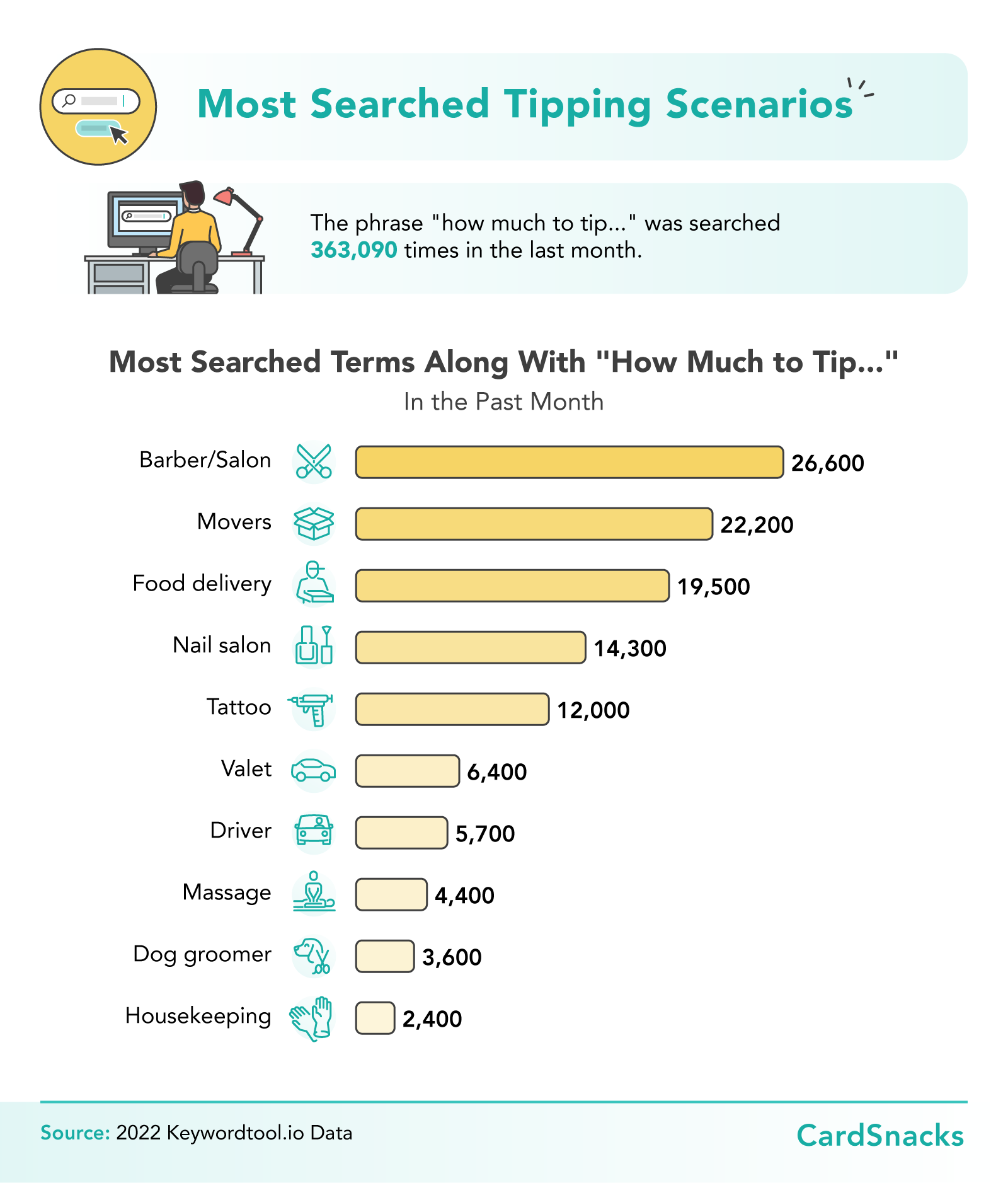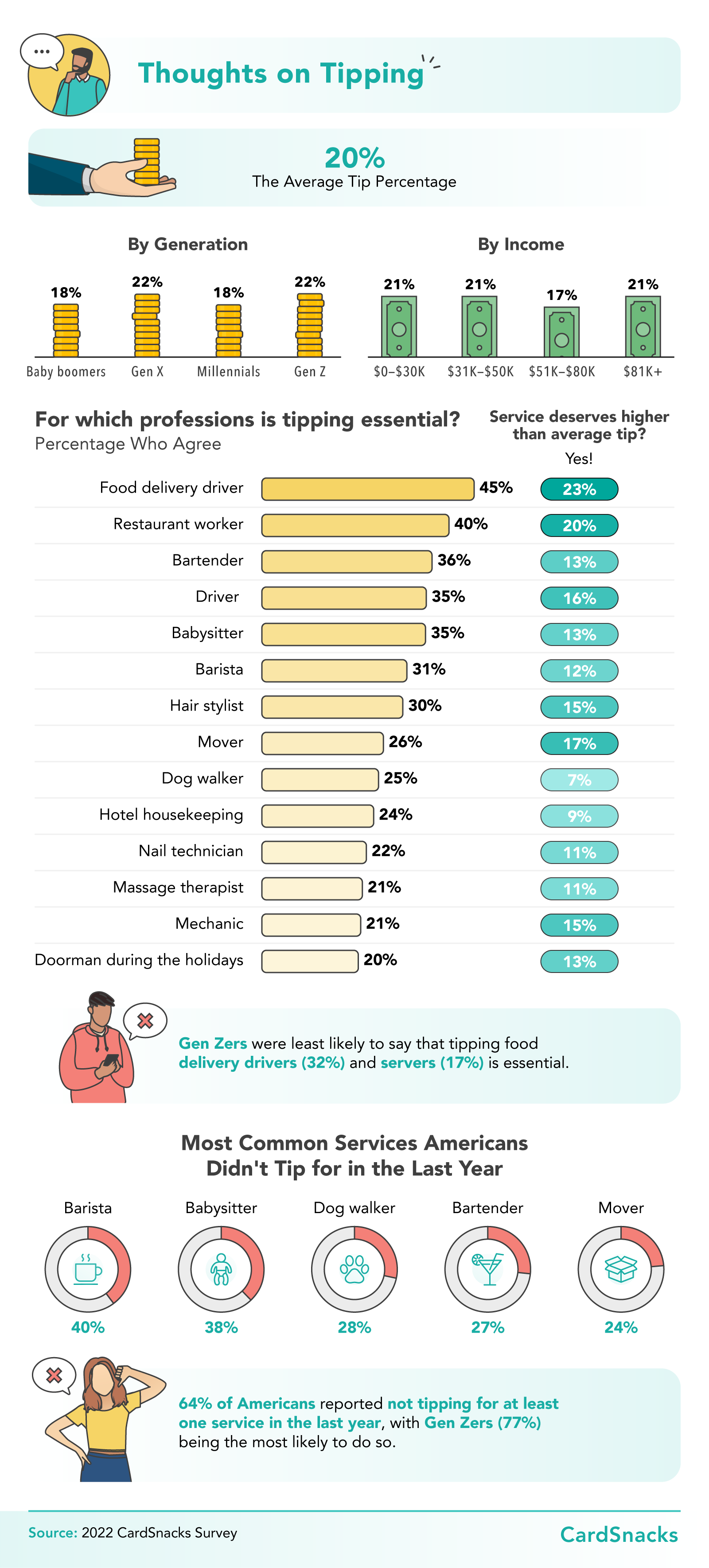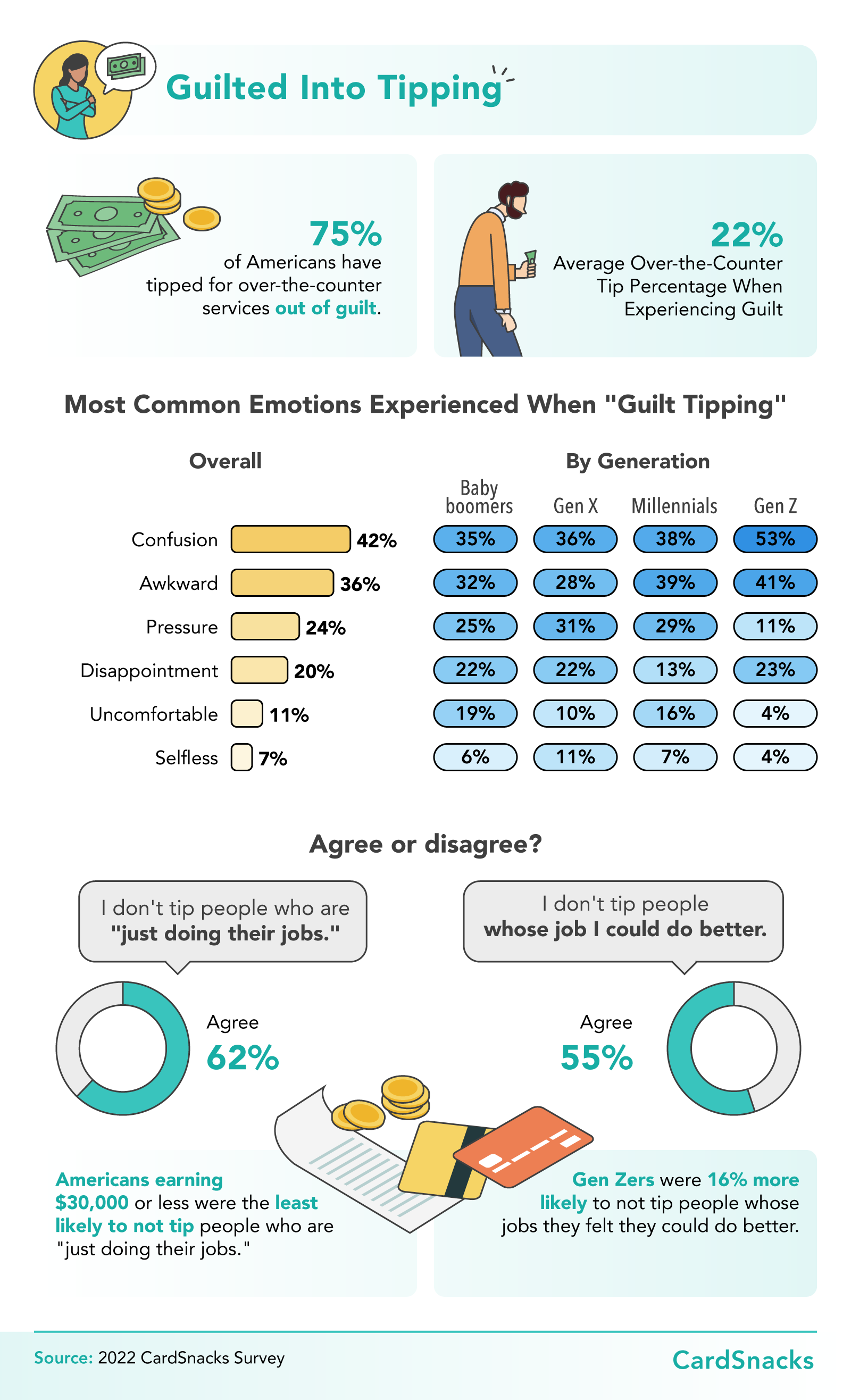Key Takeaways
- The most searched tipping scenarios involve barbers/salons, movers, and food delivery.
- Upper-middle-class Americans tip 17% on average (the lowest of all income levels), while those earning $30,000 or less tip 21% on average.
- 62% of Americans don't believe in tipping people who are "just doing their jobs."
- 75% of Americans have tipped for over-the-counter services out of guilt.
- 55% of Americans would consider tipping with gift cards as an alternative to cash.
Paying for services is easy enough when the total amount due pops up on a register screen, is typed on a bill, or is printed on a receipt. However, when those services require gratuity, things get much more complicated, and people get much more confused. When do you tip? How much should you tip? Do you tip in cash, with a card, or another way? Do you tip every time you receive a service or only in certain instances?
To determine Americans' questions and views about tipping, we collected data on the most searched terms paired with "how much to tip." Additionally, we surveyed over 1,000 Americans about their tipping habits and used that data to explore situational and generational approaches to tipping. How do Americans really feel about adding on that precious gratuity? Let's find out.
Most Questioned Tipping Situations
If you search Google for "how much should I tip my…" you'll see a lot of auto-complete
possibilities. The phrase was searched 363,090 times in the last month alone; clearly, gratuity confuses
many Americans. But which services cause the most confusion? 
The beauty and wellness industries may be the most confusing when it comes to tipping. Almost half of the top 10 most searched phrases included the terms "nail salon," "tattoo," and "massage." But barbers and salons were a cut above the rest. Searched almost 27,000 times in the past month alone, gratuity for hair stylists is the number one "how much to tip…" phrase used on Google.
Close behind were movers (22,200 searches) and food delivery workers (19,500 searches). The second place showing for food delivery workers was likely due to the sharp increase in food delivery over the past two years. It was also probably aided by the public backlash against those who have skimped on delivery driver tips. Perhaps these altercations have increased Americans' understanding that they should tip delivery drivers generously for their hard work.
What Is the Proper Tipping Etiquette?
While tipping confusion may be widespread, not every generation approaches gratuity the same. Opinions on who and how much to tip varied not only by age but also by income.

Good news for those in the service industry: We found the average tip amount to be 20% of the bill, with Gen X and Gen Z often tipping over 21%. Millennials and baby boomers tipped the lowest at around 18%, but they still tipped more generously than those with upper-mid-level incomes ($51,000-$80,000 annually). They only tipped an average of 17%, despite the lowest and highest earners tipping 20% or more.
Of course, those percentages represent tipping for a wide range of services. Respondents viewed food delivery as the most tip-essential service (45%), with nearly one-quarter believing these drivers deserve a higher tip than average. Americans also considered restaurant workers highly tip-worthy, with 40% saying tipping is essential when dining in and 20% believing restaurant workers deserve more than the average tip.
Bartenders, babysitters, and baristas seemed to cause the most tipping debate. While 36% viewed bartending as a service for which tipping is essential, nearly 27% have skipped out on tipping their bartender in the past year. Likewise, 35% think it's necessary to tip a babysitter and 31% a barista, but 38-40% also reported not tipping for these services. Unfortunately, withholding tips happens often. Over half (64%) reported not tipping for at least one service in the past year. Gen Z was the most likely not to tip, with 77% admitting as much.
Guilt Tipping
Checkout experiences can elicit a range of different emotions. Some feel confused as to whether and how much they're expected to tip, while others feel awkward or guilty about tipping. How common are these feelings among Americans?

Even though many Americans admitted to withholding a tip (64%), tipping out of guilt was even more common (75%). Ironically, the inconsistent expectations around gratuity seemed to lead to more tipping, with confusion (42%) and awkwardness (36%) being the most common reasons for guilt tipping. Gen Z experienced the most confusion about tipping, with 53% guilt tipping out of confusion compared to only 35-38% of other generations. Conversely, Gen Z was least likely to feel pressured to tip, with only 11% tipping due to pressure compared to 25-31% of other generations.
While guilt may push some to tip, judgment pushes others not to. Over half (62%) said they don't tip someone when they're "just doing their job." Another 55% said they won't tip if they feel they can do the job better themselves.
Other Ways to Tip
Whether tipping out of guilt, judgment, confusion, pressure, or decency, cash is king. However, alternative forms of tipping are gaining traction, providing new options for showing extra appreciation for services.

The best cashless tipping option was a gift card. It was the most common way to tip without cash or a card (55%) and the most preferred way to receive an alternative tip (35%) – agreed on by all four generations. Another popular cashless option was a money transfer app, but this ranked higher for receiving a tip (second) versus giving one (fourth). Cryptocurrency was also favorable, ranking second as the best way to give someone else a tip and third for receiving one.
Tip If You Want To
Gratuity is a confusing subject. Who do you tip, and how much? Is it best to use cash? Whether you search Google or ask your friends, you'll get many different answers. Tipping etiquette varies between service industries, and individual preferences and experience play a role as well.
When you do want to give an extra little something, consider a gift card. Not only are gift cards a well-received cash alternative, but thoughtfully choosing a gift card can show your service provider that you pay as much attention to them as they do to you. Handing your babysitter an extra $10 will surely suffice, but a $10 gift card to their favorite takeout place can make them feel even more appreciated.
Methodology
We collected data from www.keywordtool.io to find the terms most searched alongside "how much to tip." Additionally, we surveyed 1,304 Americans about their tipping habits.
About CardSnacks
CardSnacks is the top e-card and gift card platform for individuals and businesses.
Fair Use Statement
Do you and your friends debate about tipping etiquette? Feel free to share this article with anyone you'd like. We just ask that you do so for noncommercial purposes only and provide a link back to this page to give the authors their due credit.
